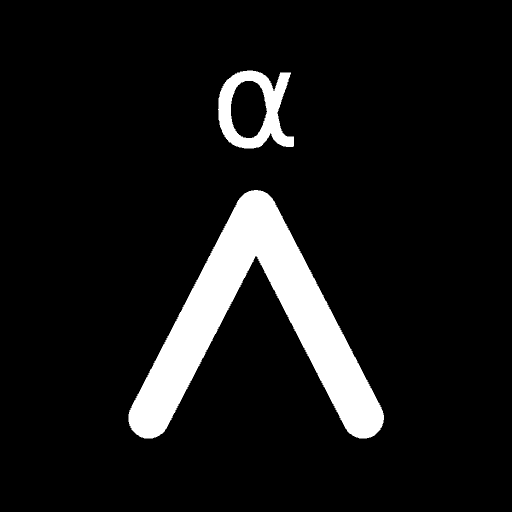Welcome fren! There’s no shortage of fake “experts” out there claiming to know what Proof of Work is, who invented it and especially why it’s bad, all while getting everything completely wrong.
I’m sure you’ve heard randoms in the media who have no idea what a blockchain even is claim that PoW “uses more energy than some country” and wonder what all the fuss is about. But besides making themselves look like muppets, they also miss the critical point that PoW solves that literally nothing else in history has solved before: trust (or more specifically, the lack of it). Let us explain.
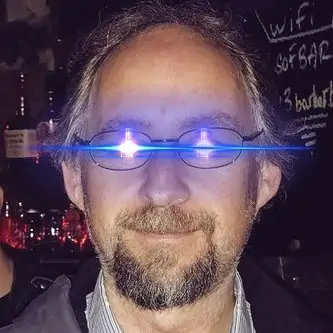
Contents
What Is Proof Of Work (PoW)?
Proof of Work or PoW was originally created to stop bad actors from overwhelming a system. As the name suggests, you perform some work (such as completing a small mathematical challenge) and then provide the results of this work in order to access the system, like an access pass. As the work imposes a small cost, it makes it impractical for bad actors to flood the system because it’d cost them too much to do so.
One of the best examples of this is to stop bad actors from sending out millions of emails without any consequences. As it basically costs nothing to send millions of emails bad actors flood the email system with spam emails all the time. If email instead used PoW, they would have to expend a small amount of effort (completing the challenge) for each email they sent, making the spamming process basically impossible.
While many people assume that PoW debuted with Bitcoin or was invented by Satoshi Nakamoto, this is not true. While Satoshi improved on it, the PoW mechanism that Bitcoin uses was actually based off the one in Hashcash, which was published by Adam Back in 1997. Satoshi makes explicit reference to this in the Bitcoin Whitepaper under reference number 6.
PoW is also extremely unique as the “proof” can be verified and trusted simply by looking at it. You don’t need to trust a third party to know that the Bitcoin Blockchain is legitimate, the proof is right there. Just like you can look at Arnold Schwarzenegger and know (without trusting any third party) that he put in the work to get that jacked, so too can you look at the blockchain and know that it’s legit. While this capability might not sound very impressive or special, we’ll explain why it’s so important below.
How Does Proof Of Work Work?
We’re sure you’ve been curious about this for a while and don’t worry, we’re going to go through how PoW works in relation to Bitcoin Mining in a simple, step by step fashion with helpful visual aids. After we understand its processes we can dive deeper into learning why they’re important.
In our Bitcoin network we have many nodes. Each node is capable of mining and contains both the Memory Pool or Mempool (shown with green transactions) as well as a full copy of the Bitcoin blockchain (shown with the blue blocks). The mempool is just all the most recent transactions that haven’t yet been confirmed into the blockchain.
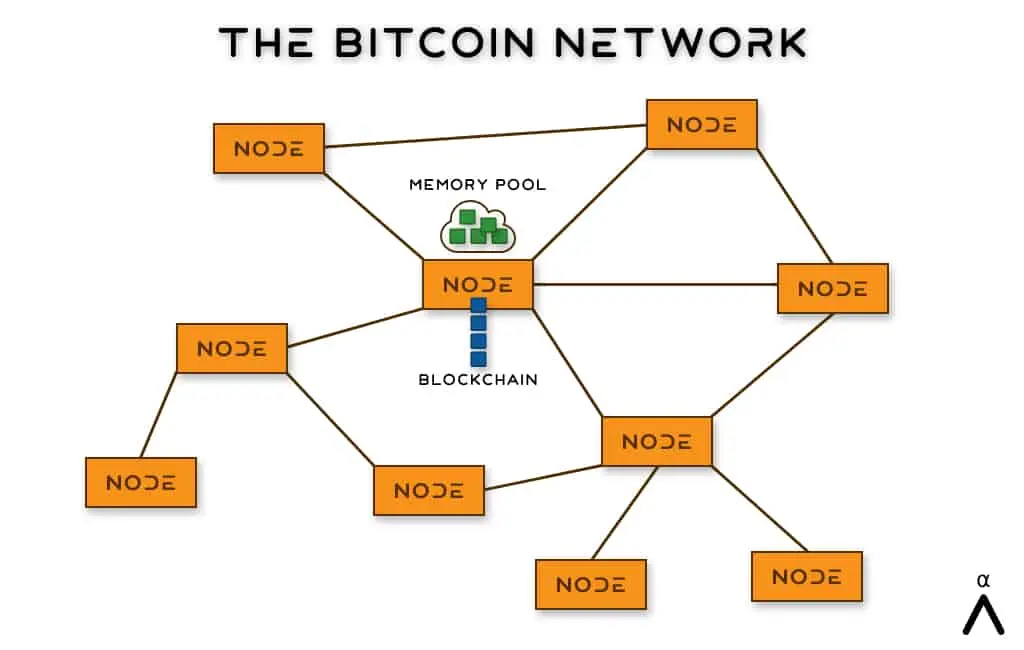
Mining takes those transactions in the mempool, bundles them together and confirms them into the blockchain.
To perform this mining process though, a miner needs to expend a lot of computer processing power or “work”. This work takes the form of a challenge.
The first step of this challenge is to take all the transactions in your memory pool and hash them. This gives you a big long random string like so.
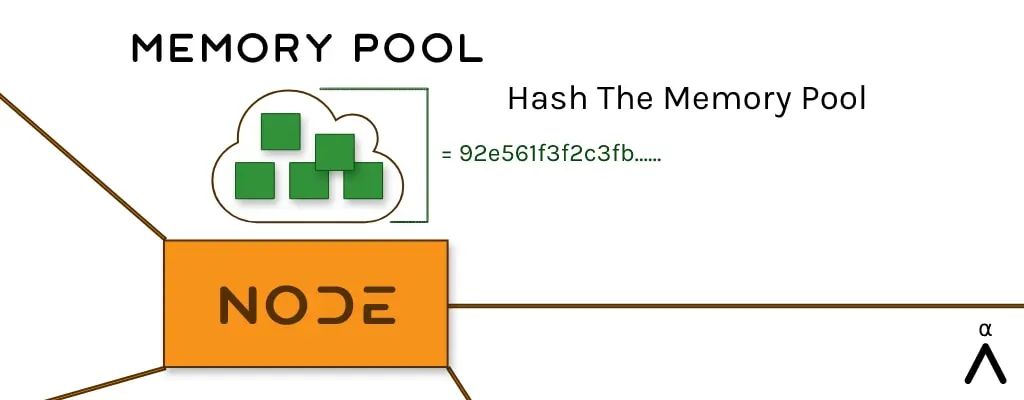
Now to win the challenge, you have to hash that string with another random number of your choosing (called a nonce) and try to get a new string that begins with a bunch of zeros.
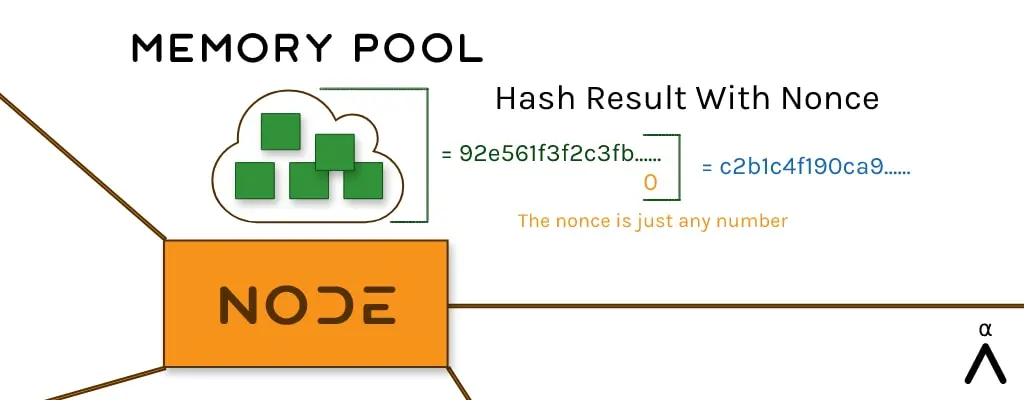
This is extremely difficult to do as the hashing process is essentially random. The only way you can win the challenge is through sheer brute force. Performing this same hashing process (Step 2) over and over and over again until…
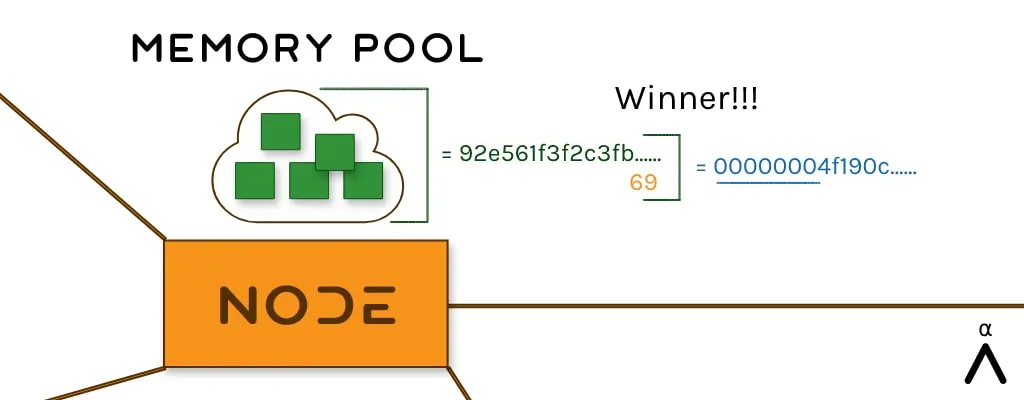
You win! Eventually with enough time and enough hashes, you’ll stumble onto a nonce that, together with the original string, hashes together to give you a result that has a bunch of zeros at the front. The number of zeros is determined by the difficulty adjustment factor which we explain in the next section.
At this point you have “solved” the block and all of the transactions inside are added onto the blockchain. You also broadcast this new block to every other node on the network which adds it to their blockchain assuming everything checks out and is valid.
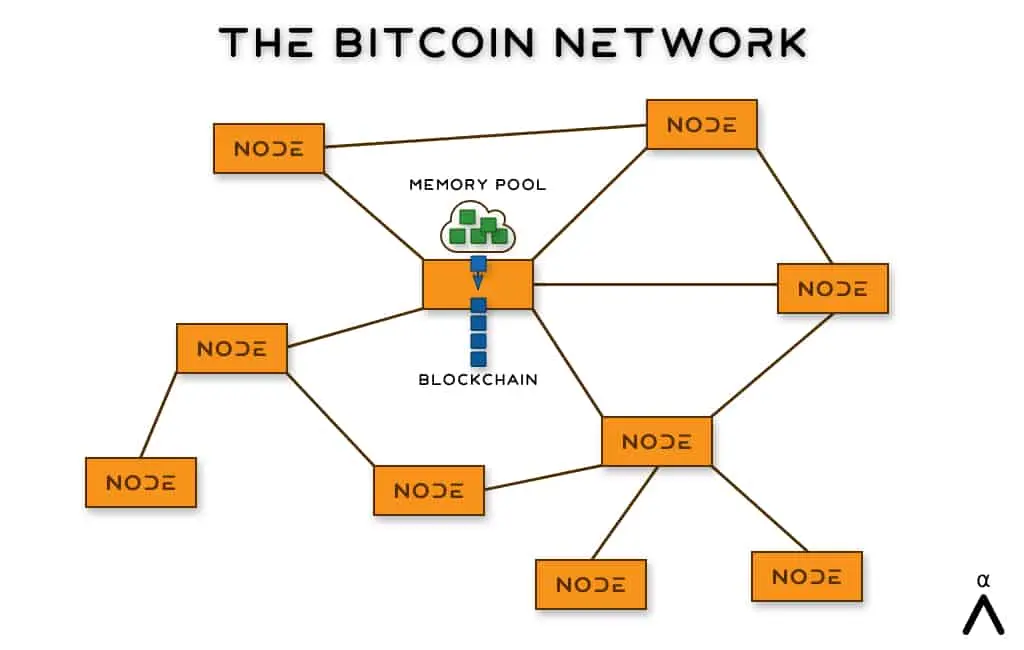
If you’re the first miner to win this challenge and broadcast your valid block to every other node you not only get to keep all the fees paid by all the transactions in that block, but a generous 3.125 BTC (the block reward) on top of that too! Yes, step 3 really is profit this time!
As we can see, the miner is tasked with doing some real life work (all the hashing in step 2) in order to complete a mathematical challenge. Once they solve the challenge (step 3) they then use that solution as proof that they’ve done the work and thus, are allowed to interact with the system (the Bitcoin network). Any miner who tries to interact with the Bitcoin network without this proof (say a bad actor trying to get fraudulent transactions into the network) is rejected.
What Is Difficulty Adjusted Proof Of Work?
Satoshi knew that technology – especially computers! – are constantly getting better and better over time. Given the current pace that computers are evolving it’s estimated that by 2030 laptops will be as powerful as some super computers were in 2022. Because of this, they had to design the Bitcoin Mining challenge process to adapt and adjust to this ever growing capability of compute power.
The mining difficulty adjustment measures how difficult it is to find a new block compared to the easiest it can ever be. After every 2,016 blocks it’s automatically recalculated to make sure that the previous 2,016 blocks would have been mined in exactly two weeks (1 block every 10 minutes = 6 blocks x 24 hours x 14 days = 2,016).
This difficulty adjustment calculation ensures that, on average, the Bitcoin network will mine blocks at an average rate of one block every ten minutes no matter how many miners join or how much faster computers get.
As the mining of blocks also results in the distribution of new bitcoins via the block rewards (see bitcoin distribution section below), this simple but brilliant difficulty adjustment mechanism also ensures that the monetary policy that issues new coins remains stable even over the course of decades of technology advancement.
New to Athena Alpha? Start today!
Proof of Work vs Proof of Stake (PoS)
The biggest and most discussed PoS cryptocurrency out there is Ethereum, so for simplicity sake, we’ll be describing and referring to how Ethereum PoS works, not any other crypto.
PoW uses real world computation (or work) to generate the “proof”. This proof is what lets the node participate in the system as described above. Proof of Stake works instead by having a large number of “staking nodes” (also called validators). These nodes must deposit or “stake” a certain number of tokens as collateral in order to be able to participate. For Ethereum validator nodes this stake is 32 ETH.
When a new block needs to be mined, the network randomly picks a validator node and they then produce and distribute the new block. If the staking node is behaving dishonestly or lazily, their collateral can be destroyed or “burned” as punishment. This is similar to how the bond that a person renting might not be returned to them if they do damage to the rental property.
Critically, with PoS there is no “proof” given along with this new block. Instead, the other staking nodes on the network validate the new block and accept or reject it. It should be noted again that you can only be a staking node if you have a Ethereum node and 32 ETH which is currently valued at $100,000+ USD.
With PoW, all you need to participate in the accepting or rejecting of the proposed new blocks is a node (which can be run on very cheap hardware like a Raspberry Pi costing about $300 total).
As most people don’t have $100,000 to just throw around, they instead have to default to simply “trusting” these richer node operators. This core issue of trust is important and we’ll elaborate on it in more detail below. It’s true that you can join a “staking pool” where you can contribute without having to commit the full 32 ETH, but as anyone who’s been deplatformed will attest to, there is no substitute for running your own hardware and controlling your own access. In summary:
- PoW: Miners produce new blocks, nodes accept or reject them
- PoS: Validators produce new blocks and accept or reject them
Why Is Proof Of Work Important?
This is a very important section of this piece. Please pay attention.
Many people, organizations, media outlets, governments and so on routinely attack Bitcoin saying that it should stop using Proof of Work. Usually, this is framed as Bitcoin being bad for Climate Change because PoW uses too much energy. Either because they simply don’t understand Bitcoin or because they’re trying to undermine it, they suggest/demand that the network move to PoS to fix this “problem”. It’s important that we discuss why this argument is flawed.
Before Bitcoin, all online money required trusting a third party to work. For offline money the world has had gold or physical cash for a long time. For example, you couldn’t send USD from one person to another online without first having a bank account and trusting that bank with the money you’re sending. Contrast this to physical cash, where you don’t need to trust anyone. You just hand the person the cash and off you go.
For decades people have wanted an online money like cash but they all failed as they couldn’t solve this trust issue. Who issues the money? Who keeps track of it? Who controls the ledger? Satoshi’s big invention was to solve this trusted third parties problem by combining online cryptographic money (how your private and public keys work) with PoW. As we noted before:
PoW is also extremely unique as the “proof” can be verified and trusted simply by looking at it. You don’t need to trust a third party to know that the Bitcoin blockchain is legitimate, the proof is right there.
It is PoW that addresses the root, core problem of trust.
With PoW, anyone can download the entire Bitcoin blockchain and verify for themselves that it’s legitimate without having to trust anyone else. You don’t have to trust that someone hasn’t altered the ledger record or slipped in some fraudulent transaction data because you can easily verify that all the work has been done.
Without PoW, we go straight back to how it was before Bitcoin where you must trust third parties like quorums, states, governments again. You must trust the bank that they haven’t altered the ledger. You must trust that the group of Ethereum staking nodes haven’t colluded or been forced by an overreaching government to do something bad. In both scenarios it always falls back to “just trust us bro”. Bitcoin fixes this!
Taking away PoW takes away the key innovation that Satoshi made. When you understand that difficulty adjusted PoW is the real invention (not crypto money) then it becomes clear why saying Bitcoin should use PoS is like suggesting you clean something without soap.
The whole point of Bitcoin was to remove trusted third parties. Why would you want to add them back in with PoS?
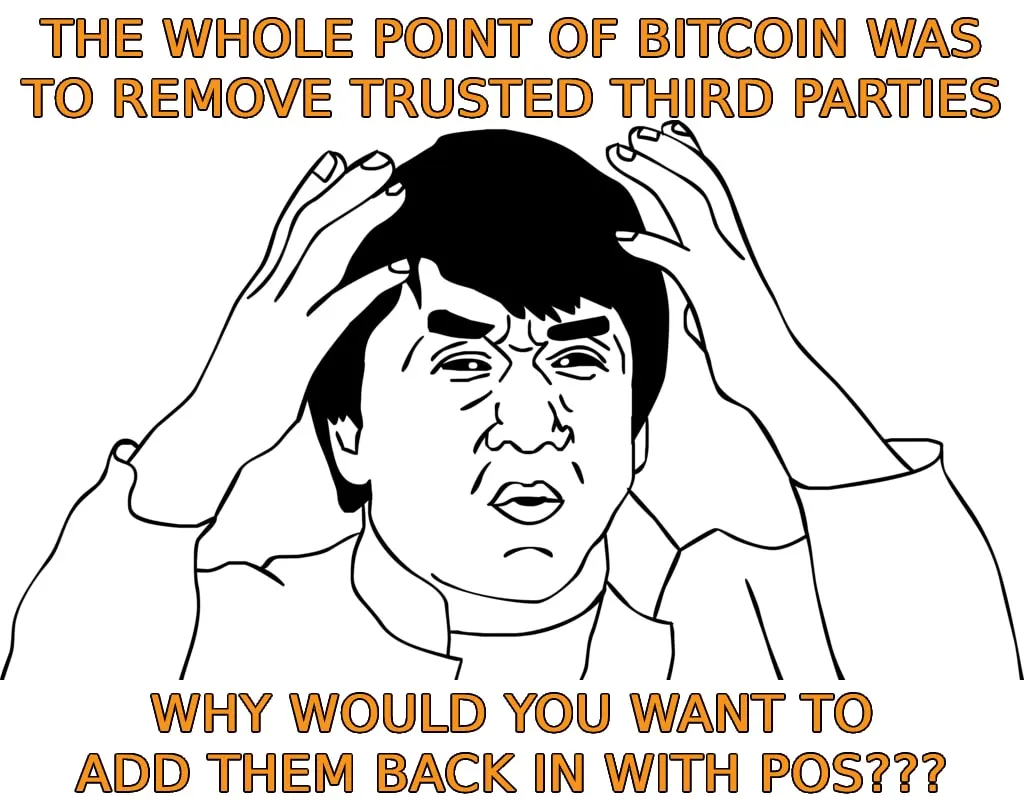
In fact, we already have money that uses PoS, it’s called fiat money! Right now, there are many banks and central banks that all have copies of ledgers throughout the world. They are the ones that get to decide what transactions are allowed and what are blocked. They are the ones that issue new coins and dictate the monetary policy of the network.
Cryptocurrencies that use PoS (such as Ethereum now) are just like fiat money, but natively “online”. This is just one difference between Bitcoin and other cryptocurrencies. Instead of trusting governments (not always the best idea) you are now trusting private companies / investors / random people (an utterly terrible idea!) in a totally unregulated market.
Proof of Work is important because it means the world can have an online money that isn’t controlled by anyone and doesn’t require trust to work. But that’s not all it does! PoW as set out by Satoshi also solves a number of other core problems that was stopping online digital money becoming a reality.
Trustless Issuance
With no central authority, Bitcoin somehow needs a way to mint and distribute the 21 million bitcoins. To do this, Satoshi decided that in order to receive these newly minted bitcoins a person had to prove that they have fairly worked for them.
This work, as explained above, had to use a real world, physically limiting thing as otherwise they could just copy/paste the work a billion times and be rich with zero effort. PoW and the mining process is what provides this “proof” to the network and as a result, miners that solve a block get both the block reward and all the fees in each of the transactions that they’ve mined.
An important distinction should also be noted at this time. Miners do not “create” new bitcoins. They create or produce new blocks. If this new block meets the rules of the Bitcoin network and is accepted and validated by all the other nodes on the network, then they will be rewarded with the block reward. Also note that it is not the miners that “validate” the blocks, that function is performed by the Nodes.
The block reward is currently 3.125 BTC. Originally it used to be 50 BTC but over the years it has been cut in half a number of times in what’s called the “Bitcoin Halving” or halvening. This lets the network mint and distribute new bitcoins while giving a higher reward to those that adopt the network (and do mining) first. A very fair process!
Dive Deeper: Bitcoin Halving
These happens every 210,000 blocks which is roughly around every 4 years. Since the genesis block there have been 4 halvings (28th Nov 2012, 9th Jul 2016, 11th May 2020 and 20th April, 2024) and when the next one occurs in 2028, this 3.125 BTC block reward will be halved once again down to 1.5625 BTC further slowing the issuance of new bitcoins.
Written into the core of the Bitcoin software is a hard coded limit of 21 million bitcoins. This means that even in a million years time, there will still only ever be 21 million coins. Given the predictable issuance of new coins and the reduction of block rewards, all 21 million of them will be mined by 2140.
Another important point to note is that increasing the amount of computing power dedicated to mining bitcoin doesn’t mean more bitcoins will be mined. If you add more miners with more computing power it just increases their chance of being rewarded in the next block.
Digital Scarcity
Closely related to issuance is how scarce the money is. This scarcity is critical when dealing with money as it’s arguably the most important characteristic of what makes something a good money. There’s many other characteristics of money as covered in our previous piece on What Is A Bitcoin Worth?
When it comes to scarcity, there are two ways bad actors can ruin it:
- Copy the existing money
- Mint large amounts of new money
Both ways result in the total supply of the money increasing and eventually leading to the money no longer being scarce. Once a money is no longer scarce, it becomes worthless and collapses.
Looking at the first way, copying existing money, it’s nothing new that information can be copied for basically zero cost. Any digital currency thus needs to find a way to get around this problem without having a controlling third party in the mix.
PoW solves this problem because each bitcoin has its full, unique history detailed in the blockchain ledger dating all the way back to its birth. Due to the real world energy required to recompute the entire blockchain, it’s impossible to alter this history. Thus, any fakes that someone might create don’t have this unique history and are rejected by the Bitcoin network ensuring the original bitcoins stay unique and scarce.
For the second way, minting large amounts of new money, history has shown time and time again that if there’s something that everyone desires, humans will inevitably come up with a way to game the system and make more of them.
PoW together with the difficulty adjustment mechanism ensure that the release of new bitcoins only occurs every 10 minutes on average, locking in the total supply and ensuring digital scarcity. It doesn’t matter if you figure out how to solve the PoW challenge faster (or throw more compute power at the problem), the difficulty adjustment mechanism will simply adjust upwards and you’ll be right back at square one earning one block reward every 10 minutes on average.
Disadvantages Of PoW
While difficulty adjusted PoW has solved the incredibly hard problem of how to have digital money without a centralized trusted third party, it also has some disadvantages.
Equipment Costs: PoW requires computation (the work) which in turn requires computers and their associated hardware and cost. This isn’t anything new as all systems, be they for money or the Internet, require hardware. In Bitcoin’s case, the hardware used (ASICs) are actually incredibly efficient as they’re custom designed to only do one thing, mining Bitcoin.
This focus ensures they are built as efficiently as possible with their cost and energy usage being obviously one of the top priorities. While top of the range Bitcoin miners can go for as much as $10,000+ USD, there are also many less powerful or second hand ones available too which aren’t as expensive.
Energy Use: Along with the hardware to do the computation you also need to expend energy too. As mining takes place online in a digital world there must be a link back to the real world as otherwise the environment is disconnected from reality and the rules can simply be changed. PoW and the forced expenditure of real world energy is this tether back to the real world and ensures that the rules cannot be changed as no one can change the physical laws of reality which is that you need energy to power a computer to do work.
Expensive Transaction Fees: Many criticize Bitcoin for its “high fees” but those fees only ever go to miners who are providing multiple key services as outlined in What Is Bitcoin Mining? One of these key services is securing the network. What they fail to realize is that while having lower fees sounds fantastic, it actually results in a less secure network as there’s less incentive for miners to participate plus it makes spamming cheap and easy.
By claiming that some other altcoin is better because it has “lower fees” what they’re really saying is that the other altcoin is insecure. As a real world example of this, someone has recently been spamming the ZCash cryptocurrency precisely because it’s only costing them $10 a day. While no one likes having to pay high fees, most people acknowledge there is a base level cost to everything. In the case of PoW, the base cost is proportional to how secure the Bitcoin network is as well as how much the open market is happy to pay for the other valuable services miners provide.
Slow Transaction Speed: Many “experts” falsely state that a disadvantage of PoW is its slow transaction speed. In reality, the number of transactions per second is constrained by the size of each block and how often they are mined, not PoW. It’s entirely possible to have the exact same PoW setup that Bitcoin has, but with one block being mined 1,000x faster than the current 10 minute average interval or to make that block hold 1,000x more transactions.
The reason a block isn’t mined this fast (or this big) however is because in order for Bitcoin to be properly decentralized, a normal, average human being with normal amounts of money must be able to buy and run their own Full Bitcoin Node.
If it’s cheap and easy to run a node then more people will do it and the network will be more diverse and decentralized. If it’s expensive and technical to run a node, then only the rich and few will do it and things will tend to be more centralized. This centralization then makes the network less secure as it’s easier to bribe / threaten / coerce a few big players than it is 100,000 smaller ones.
Learn More: Why Run A Bitcoin Node?
The quicker or bigger you make the blocks, the bigger the blockchain becomes. Currently the Bitcoin blockchain is a bit under 600 GB which will easily fit on a fast, quality 1TB SSD that costs about $50. That same drive should continue to be fine for the next 7 years too. If we were to 1,000x the block interval then the blockchain would increase in size by ~60 TB per year (instead of 60 GB per year) and obviously no normal human being is rich enough to afford this.
As another real world example of this Ethereum, which processes transactions much faster than Bitcoin, has a much bigger blockchain size. This is outlined in their minimum requirements needed to run a node which currently includes over 12 TB of disk size. While everyone would like their transaction to be confirmed as quickly as possible, this shouldn’t come at the expense of destroying the underlying security and decentralization of the entire Bitcoin network.
The Athena Assessment
Difficulty adjusted Proof of Work is a relatively simple thing that spawns a whole host of complex and interconnected interactions and benefits. From stopping bad actors from being able to cheaply spam the network, to allowing for trustless issuance of new bitcoins the precise configuration of it is truly remarkable.
While it’s true that PoW requires a large amount of energy, there is yet to be any better solution that solves the trust problem at its core. Those that suggest Bitcoin should use PoS instead entirely miss the point that removing trusted third parties is the whole point.
Removing all trust from the system also has the extra benefit of ensuring Bitcoin will live for a much longer period of time too. If there was a “Bitcoin company” or government that managed everything, then Bitcoin would likely die once that company or government died. With no leader, no company and no country at the helm this means Bitcoin is more resilient than almost all other things.
This is similar to why the electrical network or the broader Internet is so long lasting. Even if the USA collapsed tomorrow, they would still work just like Bitcoin would. Difficulty adjusted Proof of Work is truly one of the biggest and most incredible inventions in history. Its operation will very likely outlive everyone alive today. Tick tock, another block.
FAQ
What Does Proof Of Work Mean?
At its essence Proof of Work is a system that enables someone to complete a task (the work) and then be able to prove it to someone else without that someone else having to trust the original person.
Why Is Proof Of Work Needed?
Proof of Work is needed for a number of reasons. The most important one is that it enables Bitcoin to operate without any trusted third parties like a central bank or other normal banks, CEO’s or companies.
Other important functions PoW provides includes securing the network against attacks such as the Double Spending Problem, the issuance of new bitcoins without a trusted third party, enabling digital scarcity and ensuring data integrity.
Does Bitcoin Use Proof Of Work?
Yes. Bitcoin uses PoW for mining and is run on the SHA-256 hashing function.
How Does Proof of Stake (PoS) Differ From PoW?
Proof of Stake works by having a large number of “staking nodes” (also called validators). These nodes must deposit or “stake” a certain number of tokens as collateral in order to be able to participate. For Ethereum validator nodes this stake is 32 ETH.
When a new block needs to be mined, the network randomly picks a validator node and they then produce and distribute the new block. If the staking node is behaving dishonestly or lazily, their collateral can be destroyed or “burned” as punishment. This is similar to how the bond that a person renting might not be returned to them if they do damage to the rental property.
Why Do Miners Follow The Rules?
A common mistake many make with Bitcoin Mining is to assume that the miners “validate” transaction for the network. This is incorrect as miners can only combine transactions into a new block and then propose this new block to the Bitcoin network.
If that proposed new block meets all the rules of the Bitcoin network, then all the nodes on the network will accept (or validate) it. If any rules are violated then the new block will be rejected and the miner will not get their block reward.
This is why miners follow the rules, because if they don’t their newly proposed blocks will be rejected by the network and all the energy they put into creating it will be wasted.
Who Invented Proof-of-Work?
Most people credit Adam Back as the inventor.
While Satoshi improved on it, the Proof of Work (PoW) mechanism that Bitcoin uses was related to the one in Hashcash, which was introduced and published by Adam Back in 1997. Satoshi makes explicit reference to this in the Bitcoin Whitepaper under reference number 6.
In 1997, when Adam Back was working on his Hashcash paper, he wasn’t aware of an existing paper by Cynthia Dwork and Moni Naor in 1992 that also used cryptographic building blocks. This paper also came after the 1974 invention of public key cryptography by Ralph Merkle.
So as you can see, PoW as we know it today is based off or related to many others work over the past 40+ years. As such, defining one “inventor” isn’t really possible (even though most credit Adam Back as the inventor).
Why Do Cryptocurrencies Need Proof of Work?
Proof of Work performs multiple tasks such as enabling cryptocurrencies like Bitcoin to operate without any trusted third parties (eg a central bank), distributing the bitcoins to the network, protecting the network from attackers and more. It should also be noted that not all cryptocurrencies use PoW.
How Does Proof of Work Validate a Crypto Transaction?
Proof of Work and the miners that use it do not “validate” transactions.
They create and propose new blocks that have transactions in them. If this new block meets the rules of the Bitcoin network then it will be accepted and validated by all the other nodes on the network.
What Other PoW Coins Are There?
Other PoW coins include Dogecoin, Bitcoin Cash, Monero and Litecoin. Ethereum used to use PoW, however it has now transitioned to PoS.


